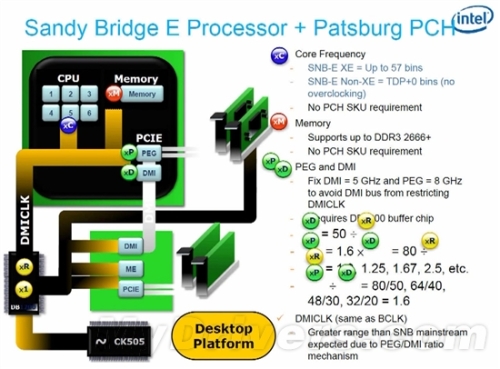 Recently we heard that Intel's next-generation processor 22nm Ivy Bridge will have limited support for FSB tuning. The latest news confirms that this "limited" is indeed very limited.
Recently we heard that Intel's next-generation processor 22nm Ivy Bridge will have limited support for FSB tuning. The latest news confirms that this "limited" is indeed very limited. We have speculated that, in addition to the 100MHz reference FSB, the Ivy Bridge should at least provide 133MHz, 166MHz, or even 200MHz FSB, a bit similar to the previous Pentium 2 hard overclocking, but the results prove that Intel is very jealous, Ivy Bridge only added an extra 133MHz, and the two FSBs at 100MHz and 133MHz also have a 5% adjustment.
Simply put, Ivy Bridge's overclocking will not have any freedom, just a little bit more open than Sandy Bridge.
As for Sandy Bridge-E, because it is provided to high-end enthusiasts, overclocking is naturally better. The FSB of the Sandy Bridge processor is called BLCK, and the Sandy Bridge-E is renamed DMICLK. Of course, it is essentially the same, but the latter is more closely related to the DMI bus.
Through the new PCI-E bus and DIM bus ratio mechanism, the FSB of Sandy Bridge-E will be available in at least five grades including 100MHz, 125MHz, 166MHz, 200MHz, and 250MHz. The adjustment of each grade should be minimal, but the choice of space is at least more.
In terms of memory frequency, Ivy Bridge can support DDR3-2133, Sandy Bridge-E will reach DDR3-2666, and even higher.
It is worth noting that the Sandy Bridge-E and Ivy Bridge are the same external clock generators used to control the FSB. They are all C505s. This means that the FSB restrictions on Ivy Bridge should be artificial, and the purpose may be to open the gap and not affect high-end products.
All in all, the overclocking on the Sandy Bridge-E platform will also be very limited. Perhaps for a long time, LGA1366 X58 platform can still get a lot of enthusiasts of all ages.
Film Capacitor,Ceramic Capacitor Co., Ltd. , http://www.nbxinqing.com